Common menu bar links
Archived Content
Information identified as archived is provided for reference, research or recordkeeping purposes. It is not subject to the Government of Canada Web Standards and has not been altered or updated since it was archived. Please "contact us" to request a format other than those available.
Analysis
After-tax income unchanged in 2008 after four years of growth
After-tax income—market income plus government transfers less income taxes—reflects income redistribution through transfers and taxes. Median after-tax income for Canadian families of two or more persons was $63,900 in 2008, virtually unchanged from 2007 and the first year since 2003 with no notable increase.
For unattached individuals, after-tax income remained stable from 2007 to 2008 at $24,900. For the first time in three years, no significant change was observed.
While year-to-year changes were negligible at the national level, a few exceptions can be found at finer levels of geography. Median after-tax income for families with two persons or more rose 5.7% in British Columbia and Saskatchewan. In the other provinces, it was unchanged in 2008 from 2007.
For unattached individuals, median after-tax income in Alberta rose 13% to $33,900 and in Manitoba, 12% to $26,200 in 2008.
Noticeable differences are apparent in median after-tax income of families between the provinces and selected census metropolitan areas (CMAs) and census agglomerations (CAs) (Figure 1). At the provincial level, median after-tax income was significantly higher in Ontario and westward than in Quebec and Atlantic Canada. Since 2004, Alberta has had the highest median after-tax income for economic families with two persons or more—$77,200 in 2008. At the CMA/CA level, Saskatoon, Calgary, Edmonton, Victoria and Vancouver all reported higher median after-tax income than the national median of $63,900.1
Market income remained stable
Comprised of earnings and income from investments, private pensions and other sources,2 market income is closely linked to labour market conditions. According to the Labour Force Survey, the annual employment rate for the population aged 15 to 64 rose a slight 0.1 percentage points from 2007 to 2008, to 73.7%.3
Median market income was virtually unchanged for the main family types in 2008 compared with 2007 (Chart 1). In 2008, economic families with two persons or more had median market income of $64,900. Senior families—families where the major income earner is 65 years of age or older—earned $25,500 in median market income, compared with $72,500 for non-senior families. Unattached individuals posted $21,300 in median market income in 2008.
Chart 1
Median market income, by family type, 2007 and 2008
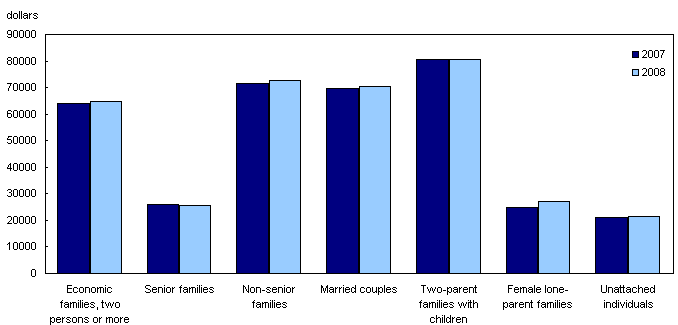
Among the provinces, median market income remained stable on a year-to-year basis for most family types. However, median market income increased significantly for non-senior families in three provinces: in New Brunswick, the median rose 9.3% to $59,800 in 2008; in Saskatchewan it gained 8.2% to $78,100; and in British Columbia, it increased by 6.6% to $76,000.
How market income has changed for seniors
From 2007 to 2008, the composition of market income for all Canadian individuals did not change. However, over the long term, the composition of market income—how much income came from which sources—has changed significantly, especially for seniors.4
Since the early 1990s, seniors’ market income has been primarily composed of income from private pensions. During the 1970s and 1980s, however, income from earnings and investments made up greater shares of market income (Chart 2). The proportion of market income that came from earnings decreased steadily, from 38% in 1976 to 9% in 2001. Since then, the share has slowly increased to 16% in 2008. Still, private pension income made up 59% of market income in 2008, compared with 22% in 1976.
Chart 2
Composition of aggregate market income for individuals 65 and older, 1976 to 2008
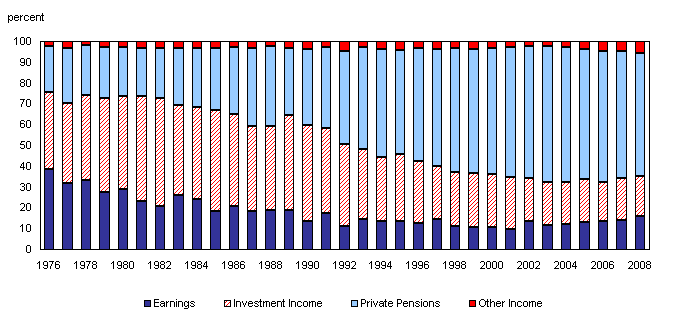
The proportion of seniors who received some market income increased by 20 percentage points between 1976 and 2008 (Chart 3). Greater labour market participation by women contributed to this trend: 76% of senior women received market income in 2008, compared with 50% in 1976. The proportion of senior men who received market income also rose, albeit to a lesser degree, from 75% in 1976 to 86% in 2008.
Chart 3
Percentage of individuals 65 and older with market income, 1976 and 2008
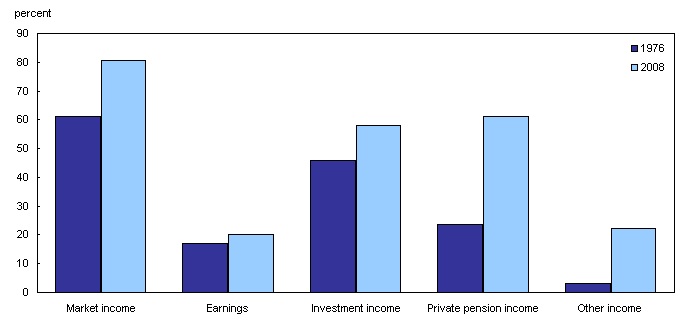
Private pension income was the component of market income that gained the greatest share from 1976 to 2008. In 2008, 61% of seniors received private pension income, up from 24% in 1976. The proportion of seniors with investment income also grew.
Among seniors who earned market income, the median amount they received in 2008 was $12,000, up from $8,200 in 19765 (Chart 4). The median of each component reveals important changes over time. Seniors’ median earnings, for example, decreased from $14,000 in 1976 to $2,900 in 2008. Similarly, among those who received investment income, the median declined from $3,300 in 1976 to $1,600 in 2008. However, the median private pension income for recipients increased to $10,900 in 2008, from $6,100 in 1976.
Chart 4
Median market income and components for individuals 65 and older, 1976 and 2008
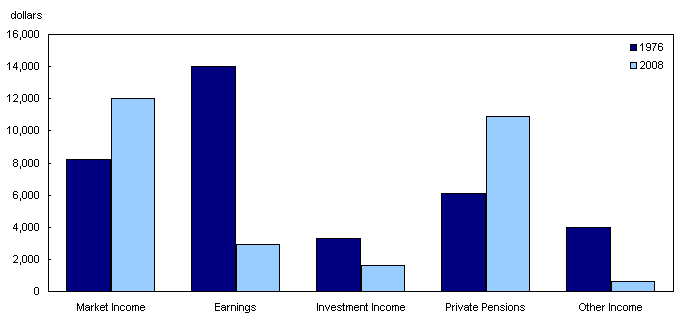
While more seniors are working, they are taking home less. This finding is consistent with other researchers who have highlighted older workers’ growing labour force participation. According to researchers, many seniors choose flexible work arrangements, such as part-time or seasonal work (Turcotte, et al., 2007; Duchesne, 2004; Walsh, 1999).
Among non-seniors, consistency in market income composition
Non-seniors derive their market income primarily from earnings—just over 90% in 2008. This share has been relatively stable since 1976. The median for those with earnings has hovered around $30,000 since 1976; in 2008 it was $30,500.
The other components combined make up less than 10% of market income for non-senior or working-age Canadians. The share of market income from investment income was 3.3% in 2008, down from the 1982 peak of 6.2%. This corresponds with a period of historically low savings rates, the result of long-term positive economic growth and low interest rates through the end of the 1990s. The 2008 median investment income for working-age recipients was $400, 29% of the 1981 series historic peak of $1,400.
Among Canadians younger than 65, private pensions have represented a small-but-growing share of market income: 0.6% in 1976, and a still-marginal 2.9% in 2008.
Stability in government transfers and income taxes
Government transfers are programs such as Employment Insurance, the Canada Pension Plan and Quebec Pension Plan, Old Age Security, Guaranteed Income Supplement, and Canada Child Tax Benefit.
Families’ median government transfers were little changed in 2008 from 2007. Median government transfers among families of two persons or more were $4,800 in 2008.
However, transfers vary widely across different family types. Non-senior families reported median government transfers of $2,900; senior families reported $24,100 in 2008. Among those living alone, senior individuals received median government transfers of $15,400; non-senior individuals received $400.
Median income taxes—both federal and provincial —were stable for most family types (Chart 5 ). Families of two persons or more paid a median of $8,800 in income taxes in 2008, similar to 2007. Unattached individuals paid $2,400 in median income taxes, unchanged from 2007. In contrast, senior families paid less—$2,400 in 2008, $500 lower than in 2007.
Chart 5
Median income tax paid by families, 1976 to 2008
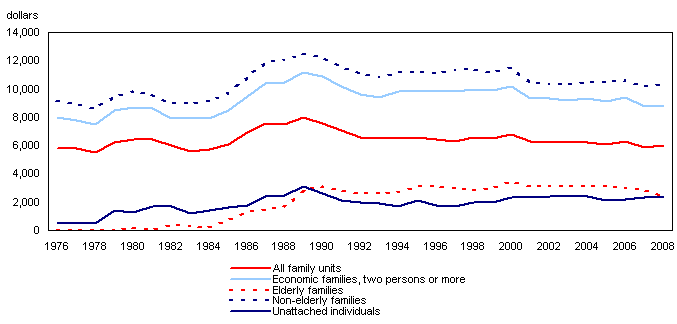
After-tax income across the distribution
This section examines income at the person level, where individuals are represented by their adjusted after-tax household income.6 This adjustment yields indicators that reflect after-tax income defined on a per-person basis. Analysis can be done at a finer level by breaking the population of individuals into five equal-sized groups, or quintiles, from lowest adjusted after-tax income to highest adjusted after-tax income.
As we saw for families and the unattached, after-tax income remained unchanged from 2007 to 2008. The third and fourth quintiles experienced some growth in after-tax income; the other quintiles saw no significant change (Table 1). In the previous two years, all quintiles posted significant increases in adjusted after-tax income.
| 2004-2005 | 2005-2006 | 2006-2007 | 2007-2008 | |
|---|---|---|---|---|
| Quintile 1 | 2.9 | 5.0* | 4.1* | 0.0 |
| Quintile 2 | 2.4* | 2.0* | 4.3* | 1.1 |
| Quintile 3 | 2.4* | 1.4* | 3.4* | 2.2* |
| Quintile 4 | 2.4* | 1.5* | 3.2* | 2.3* |
| Quintile 5 | 0.3 | 2.9* | 3.6* | 2.7 |
| * -denotes significant change | ||||
The 20% of persons in the bottom quintile posted average household adjusted after-tax incomes of $15,400 in 2008, unchanged from 2007. Those in the second quintile saw no significant change from 2007: their average adjusted after-tax income was $27,200 in 2008.
Persons in the third and fourth quintiles were the only groups who experienced growth in 2008. Both saw their average adjusted after-tax incomes rise by just over 2% from 2007 to 2008, to $37,200 for the third quintile and $49,300 for the fourth quintile. Persons in the fifth quintile posted no significant growth in 2008: their adjusted after-tax income was $83,600.
The ratio of the top quintile to the bottom quintile, one of the commonly used income inequality measures, did not change between 2007 and 2008. In 2008, the 20% of persons with the highest adjusted after-tax income had, on average, 5.4 times the adjusted after-tax income of those in the bottom 20%, virtually unchanged since 2000.
Different ways of looking at low income
To provide a more complete picture of low income,7 with this release Statistics Canada is implementing an approach that uses two low-income indices—incidence and depth—and three complementary low income lines:8 Statistics Canada’s Low Income Cut-off (LICO) and Low Income Measure (LIM) as well as the Market Basket Measure (MBM) developed by Human Resources and Skills Development Canada (HRSDC). While each looks at low income from a different angle, they give a generally consistent picture of low income over time. No one measure is best; each has its own strengths and weaknesses in the study of low income (Zhang, 2010).
In this report, each of the three lines is examined for a specific purpose. To better understand low income, one should examine all lines in parallel. In fact, an Integrated Report on Low Income, which uses a multi-line, multi-index approach, is forthcoming.
After-tax low income cut-offs showed no change in low-income situation
The LICOs have a long history in Canada. They were first published using 1959 Survey of Family Expenditures data, and were rebased in 1992. They represent an income threshold below which a family would likely devote a larger share of its income to necessities (food, clothing, and shelter) than an average family would.
According to the after-tax LICO, or LICO-AT, just over 3 million Canadians lived in low income in 2008, virtually unchanged from 2007. This accounts for 9.4 % of the population (Chart 6). Additionally, the average depth of low income9 was 33% in 2008, unchanged from 2007 and little changed since the late 1990s.
About 606,000 children younger than 18 lived in low-income families in 2008, unchanged from 2007 but fewer than the 854,000 in 2003. The proportion of children in low-income families was 9.0% in 2008, half the 1996 peak of 18%.
In 2008, about 218,000 of these children in low income lived in female lone-parent families, making up 36% of children in low income. Almost one-quarter (23%) of children living in female lone-parent families were living in low income in 2008, unchanged from 2007 but lower than its latest peak of 56% in 1996.
The incidence of low income for children living in two-parent families was 6.5% in 2008, virtually unchanged from 2007.
About 1.3 million unattached individuals, or 27% of the population, lived below the LICO-AT in 2008, virtually unchanged from 2007. On average, unattached individuals had after-tax income 38% lower than their low income cut-off.
About 12% of unattached senior men lived in low income in 2008, with an average depth of 15%. Both these indices were unchanged from 2007.
Among unattached senior women, 17% lived in low income in 2008, unchanged from 2007. The average depth of low income was 13% in 2008, also unchanged from 2007.
Among seniors living in families, the incidence has remained relatively stable over the years: 1.6% of seniors lived in families below the LICO-AT in 2008.
Chart 6
Incidence of low income using the LICO-AT, 2008
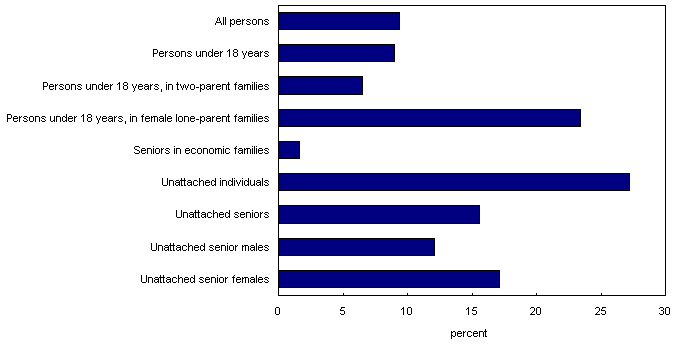
Taking regional differences into account using the Market Basket Measure
Another perspective on low income is the MBM, developed by HRSDC. It is an estimate of the cost of a specific basket of goods and services (food, shelter, clothing, footwear, transportation, and other expenses) representing a modest, basic standard of living.10 It is defined for a reference family of one male and one female adult aged 25 to 49 with two children (a girl aged 9 and a boy aged 13) in 49 geographical areas within the 10 provinces. The cost of this basket is then compared with the disposable income11 of families to determine if they were in low income. Because it is constructed using costs at the sub-provincial level, it provides a measure more sensitive to regional differences in living costs than the LICO and the LIM. However, changes in the incidence or depth of low income using the MBM concept are affected not only by changes in income, but also by price changes for the items within the basket, which may differ between regions.
The incidence of low income was stable in almost all provinces from 2007 to 2008. Neither the MBM, the LICO-AT, nor the LIM showed significant shifts from 2007 to 2008 in most provincial incidences or depths of low income. Only the MBM for Quebec shows an increase in the incidence, from 8.2% to 9.5%. This is partly explained by a larger increase in 2008 MBM thresholds in that province than in other provinces.
While incidences for most provinces showed no statistically significant changes from 2007 to 2008, the 2008 provincial figures generally showed lower incidences than at the start of the millennium.
In Newfoundland and Labrador, 13% of persons lived in low income in 2008, as defined by the MBM, compared with 21% in 2000 (Chart 7). Prince Edward Island also experienced a decline in incidence, from 15% in 2000 to 10% in 2008. For Nova Scotia and New Brunswick, the incidence remained fairly stable through the period (13% and 12% respectively in 2008). Despite the increase in the 2008 MBM thresholds in Quebec, the incidence was still lower than at the beginning of the millennium (12%). Quebec saw a significant reduction in the first part of this past decade.
In Ontario, the incidence of low income measured by the MBM was stable through the 2000-to-2008 period (9.4% in 2008). In the prairie provinces, MBM incidence began to decline mid-decade, down to 7.8% in Manitoba, 9.1% in Saskatchewan and 5.9% in Alberta in 2008 (Chart 8). In contrast, the low-income trend in British Columbia was generally downward through the decade. In 2000, 17% of persons living in British Columbia lived in low income, compared with 12% in 2008.
Chart 7
Incidence of low income using the MBM, all persons, selected provinces, 2000 to 2008
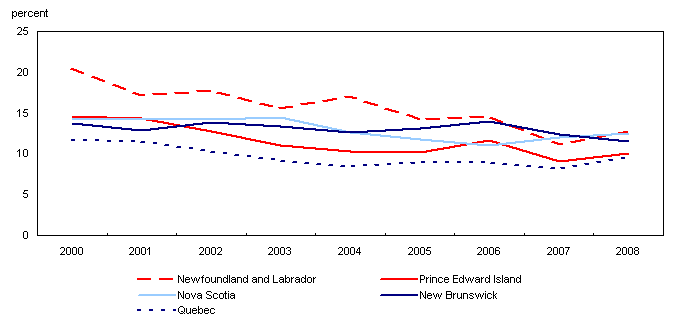
Chart 8
Incidence of low income using the MBM, all persons, selected provinces, 2000 to 2008
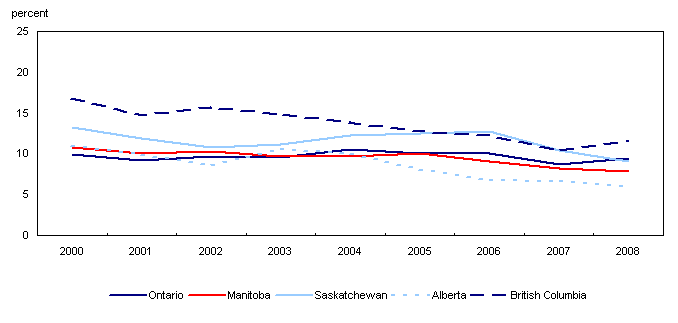
Despite some decreases in the incidence of low income, the depth of low income remained stable from 2000 to 2008 in all provinces (Chart 9).
Chart 9
Depth of low income using the MBM, all persons, by province, 2000 and 2008
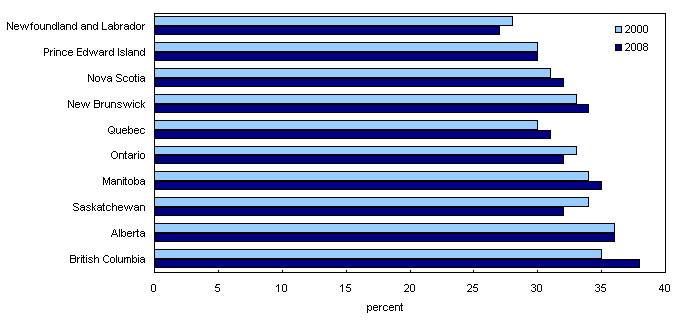
Comparing change in selected countries
Yet another way of looking at low income is the distribution of income. This can be done using the Low Income Measure (LIM), defined as a fixed percentage, 50%, of the median income of all individuals. Each individual’s income is represented by their ‘adjusted’ household income. The adjustment is made to reflect the fact that household needs increase based on their size.
One advantage of the LIM is that it can be used to make international comparisons, since there are no embedded prices or expenditure assumptions—it is based strictly on the distribution of income.
Because some conceptual differences12 remain between countries, this section will report on the change in the incidence and depth of low income instead of levels of low income.
Chart 10
Change in incidence and depth of low income, selected countries, 2007-2008
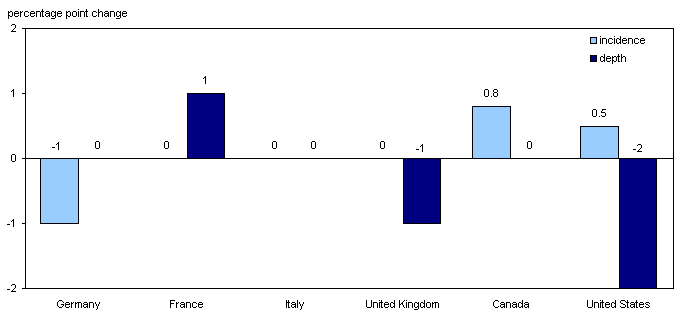
Sources: Eurostat. “Data explorer” Table Database
Bureau of Labour Statistics. Current Population Survey Database
Statistics Canada, Survey of Labour and Income Dynamics
Among all individuals living in G8 countries (excluding Japan and Russia) the incidence of low income was unchanged in 2008 from 2007 in France, Italy, and the United Kingdom13 (Chart 10 ). Canada’s incidence rose 0.8 percentage points and the United States’, 0.5 percentage points; Germany’s declined by 1 percentage point.
The depth of low income changed in only half the selected countries from 2007 to 2008. The depth decreased in two countries—by 1 percentage point in the United Kingdom and 2 percentage points in the United States. In France, the depth rose by 1 percentage point.
The OECD produced a report on the low income situation across the world (OECD,2008).
Crossing the low-income line
Family income can change from one year to the next, for many reasons. Family members may change their labour market involvement: they may get or end a job, or change the number of hours they work. They may get a promotion or lose their job. Additionally, changes to the composition of the family, such as birth, death or separation, may change the resources available or the number of persons sharing the resources. A family may move to a larger city, which may affect the threshold that their income is compared with. For these and other reasons, families may move into or out of low income.
Chart 11
Transitions of persons into and out of low income between 2006 and 2007, based on LICO-AT
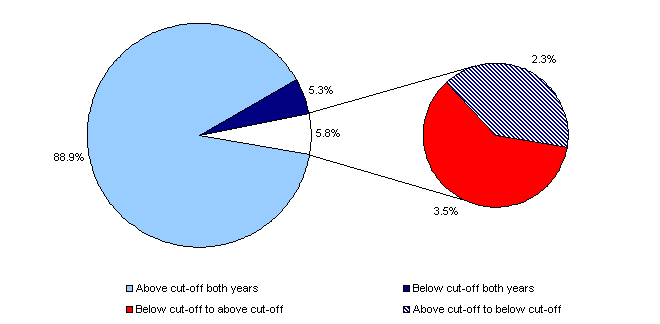
Chart 12
Transitions of persons into and out of low income between 2007 and 2008, based on LICO-AT
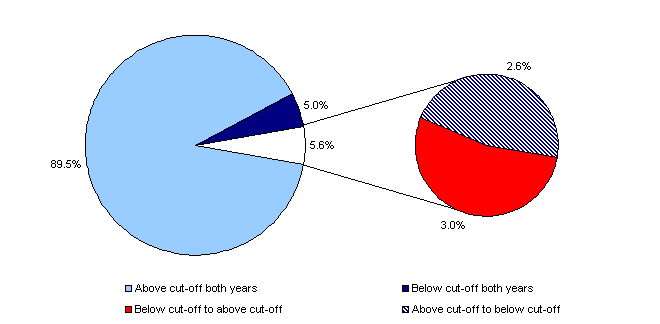
The longitudinal nature of SLID enables analysis of changing family income. Analysis using the LICO-AT showed that from 2007 to 2008, the turnover in the low-income population was balanced—almost the same proportion moved into low income as moved out, about 3% (Chart 12). This is in line with the stability in the incidence of low income between those two years. In comparison, from 2006 to 2007, 3.5% moved out of low income, and 2.3% moved into low income (Chart 11). Analysis using the MBM reached the same conclusion; analysis using the LIM showed similar proportions moving in and out of low income in both periods.
References
Duchesne, Doreen. 2004. “More Seniors at Work.” Perspectives on Labour and Income. Vol. 5 no. 2. Spring. Statistics Canada Catalogue no. 75-001-XIE /pub/75-001-x/10204/6789-eng.pdf
Hatfield, Michael, Wendy Pyper and Burton Gustajtis. 2010 “First Comprehensive Review of the Market Basket Measure of Low Income”. Applied Research Branch paper. Human Resources and Skills Development Canada. Summer. Forthcoming:
www.hrsdc.gc.ca/eng/publications_resources/research/categories/sei.shtml or by email: MBM-MPC@hrsdc-rhdcc.gc.ca
Organisation for Economic Co-operaton and Development (2008). Growing Unequal? Income Distribution and Poverty in OECD Countries. http://www.oecd.org/document/53/0,3343,en_2649_33933_41460917_1_1_1_1,00.html
Statistics Canada. 2010. “Low Income Lines, 2008–2009”. Income Research Paper Series. 75F0002MIE www.statcan.gc.ca/bsolc/olc-cel/olc-cel?catno=75F0002MWE2010005
Turcotte, Martin and Grant Schellenberg. 2007. A Portrait of Seniors in Canada 2006. Statistics Canada Catalogue no. 89-519-XIE. Ottawa. 301pp. /pub/89-519-x/89-519-x2006001-eng.pdf (p. 67).
Walsh, Mark. 1999. “Working Past Age 65.” Perspectives on Labour and Income. Vol. 11 no. 2 Summer. Statistics Canada Catalogue no. 75-001-XIE /studies-etudes/75-001/archive/e-pdf/4601-eng.pdf
Zhang, Xuelin. 2010. “Low Income Measurement in Canada: What Do Different Lines and Indexes Tell Us?” Statistics Canada. Income Research Paper Series 75F0002MIE
/pub/75f0002m/75f0002m2010003-eng.htm
Eurostat.“Data explorer” Table Database. http://epp.eurostat.ec.europa.eu/portal/page/portal/statistics/search_database. Tables ilc_li02 and ilc_li11. (accessed May, 2010)
Bureau of Labour Statistics. Current Population Survey Database. www.bls.census.gov/ferretftp.htm (microdata runs completed May 2010).
1 Only CMAs and CAs with a population of at least 175,000 persons and a survey sample of at least 300 economic families are included in this analysis.
2 ‘Earnings’ is the sum of wages, salaries and net self-employment income. ‘Private pensions’ excludes RRSP withdrawals for those under 65. It does include RRSP annuities and RRIF withdrawals. ‘Other income’ includes other taxable income and alimony payments.
3 Statistics Canada. CANSIM table 282-0002, Labour Force Survey estimates (LFS), by sex and detailed age group, annual.
4 Considering the composition of market income, analysis is best done using individuals rather than families as the base unit.
5 For this portion of the analysis, individuals who had zero for an income source are excluded from the calculation. The median is a measure of central tendency that does not depend on the aggregate amount, but on the individual amount for a variable. Because the median value for the different components will likely not be represented by the same individual, the median values of the components of market income will never sum to median market income, although the calculation was done on the same population.
6 The adjusted income is calculated by dividing the household income by the square root of the household size. This adjustment takes into account the economies of scale present in larger households. It also enables the combining of families and unattached individuals for analysis.
7 Starting with this release, low-income statistics will no longer be reported at the family level, but instead at the individual level, where each individual is represented by his or her family income (for the LICO and the MBM) or household income (for the LIMs). In this way, the statistics are not distorted by variations in the size of families in the various groups of interest. For example, instead of talking about the incidence of low income in lone-parent families, we can talk about the incidence of low income among individuals who live in lone-parent families.
8 See Statistics Canada (2010) for a detailed description of how these lines are defined.
9 For individuals in low income, the depth is the difference between their family income and their low-income threshold, expressed as a percentage of that threshold.
10 The MBM underwent a comprehensive review of the thresholds in 2009 and 2010. This review resulted in a rebased set of thresholds for 49 regions across the 10 provinces. Hatfield, Pyper and Gustajtis (2010) provide a complete review of the decisions and a discussion of the impact on the incidence and depth of low income from 2000 to 2007. Some changes were made to the entire time series, but some were made only to parts of the period. Of particular note, the introduction of a new National Nutritious Food Basket led to a larger increase in the thresholds in 2008, compared to other years.
11 Disposable income is defined as the amount remaining after deducting the following from total family income: total income taxes paid; the personal portion of payroll taxes; other mandatory payroll deductions, such as contributions to employer-sponsored pension plans, supplementary health plans, and union dues; child support and alimony payments made to another family; out-of-pocket spending on child care; and non-insured but medically prescribed health-related expenses such as dental and vision care, prescription drugs, and aids for persons with disabilities.
12 Differences include the definition of income and the equivalence scale used. For example, in the European countries, inter-household transfers and imputed rent are included in income; they are not included in income in Canada or the United States.
13 Throughout Income in Canada, ‘change’ refers to differences that are statistically significant. In this section, where international comparisons are made, Canada is the only country where it can be determined if differences are statistically significant using bootstrap weights. For all other countries, changes cannot be tested for significance, so all changes are mentioned. As well, the incidences for the European countries are not available at the same level of precision (rounded) as for Canada and the United States. This means that, for the European countries, some change may be masked by this lack of precision.

